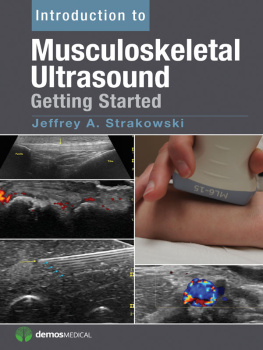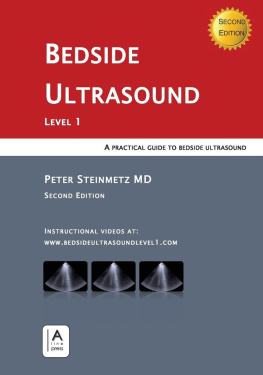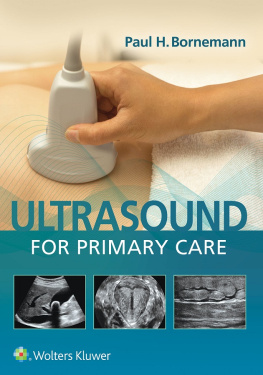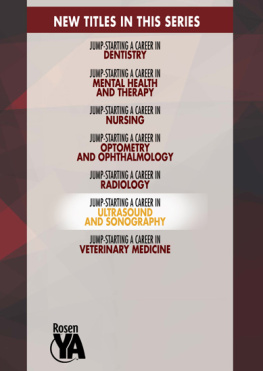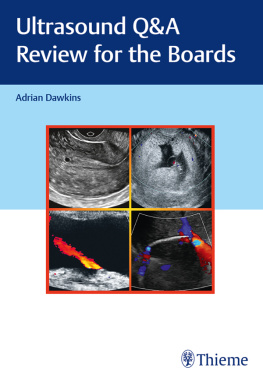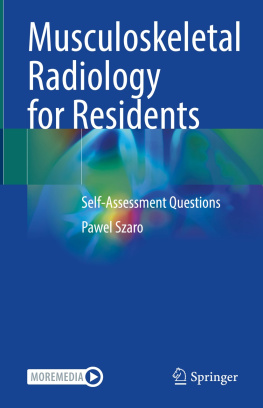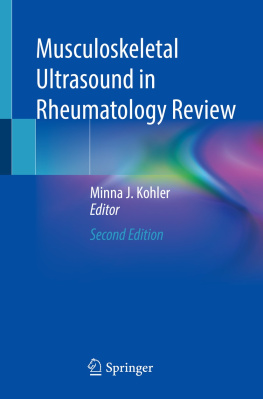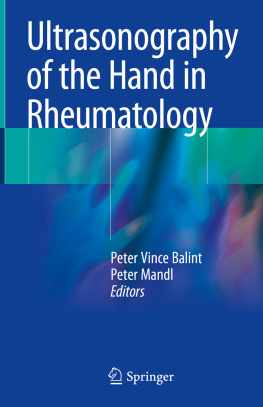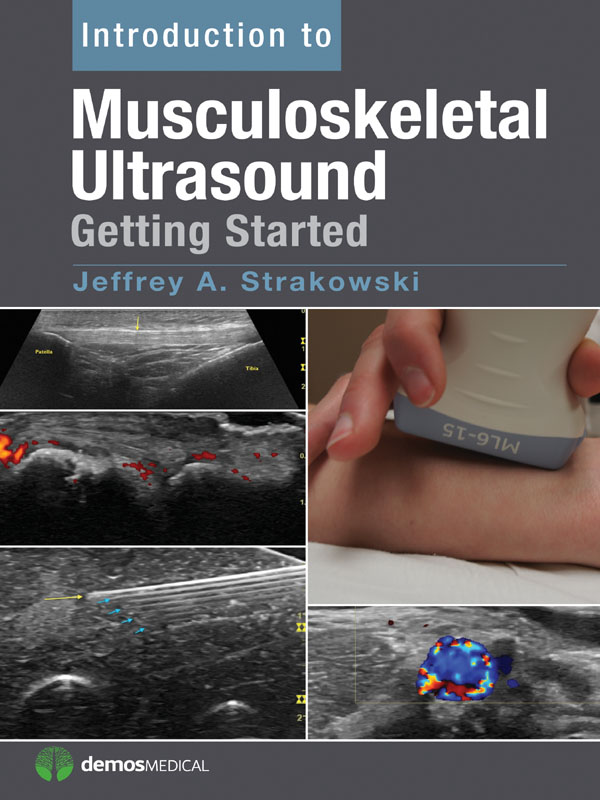Introduction to Musculoskeletal Ultrasound
Introduction to Musculoskeletal Ultrasound
Getting Started
JEFFREY A. STRAKOWSKI, MD
Clinical Associate Professor
Department of Physical Medicine and Rehabilitation
Ohio State University School of Medicine
Columbus, Ohio

Visit our website at www.demosmedical.com
ISBN: 9781620700655
e-book ISBN: 9781617052309
Acquisitions Editor: Beth Barry
Compositor: diacriTech, Chennai
2016 Demos Medical Publishing, LLC. All rights reserved. This book is protected by copyright. No part of it may be reproduced, stored in a retrieval system, or transmitted in any form or by any means, electronic, mechanical, photocopying, recording, or otherwise, without the prior written permission of the publisher.
Medicine is an ever-changing science. Research and clinical experience are continually expanding our knowledge, in particular our understanding of proper treatment and drug therapy. The authors, editors, and publisher have made every effort to ensure that all information in this book is in accordance with the state of knowledge at the time of production of the book. Nevertheless, the authors, editors, and publisher are not responsible for errors or omissions or for any consequences from application of the information in this book and make no warranty, expressed or implied, with respect to the contents of the publication. Every reader should examine carefully the package inserts accompanying each drug and should carefully check whether the dosage schedules mentioned therein or the contraindications stated by the manufacturer differ from the statements made in this book. Such examination is particularly important with drugs that are either rarely used or have been newly released on the market.
Library of Congress Cataloging-in-Publication Data
Strakowski, Jeffrey A., author.
Introduction to musculoskeletal ultrasound: getting started / Jeffrey A. Strakowski.
p. ; cm.
Includes bibliographical references and index.
ISBN 978-1-62070-065-5ISBN 978-1-61705-230-9 (e-Book)
I. Title.
[DNLM: 1. Musculoskeletal Systemultrasonography. 2. Ultrasonographymethods. WE 141]
RC925.7
616.707543dc23
2015028595
Special discounts on bulk quantities of Demos Medical Publishing books are available to corporations, professional associations, pharmaceutical companies, health care organizations, and other qualifying groups. For details, please contact:
Special Sales Department
Demos Medical Publishing, LLC
11 West 42nd Street, 15th Floor
New York, NY 10036
Phone: 800-532-8663 or 212-683-0072
Fax: 212-941-7842
E-mail:
Printed in the United States of America by Bradford & Bigelow.
15 16 17 18 / 5 4 3 2 1
To my familyDanielle, Nathan, Devin, and Hannah for their love, support, and tolerance.
Also to my residents whose excitement for learning helped inspire the creation of the book.
Contents
Preface
The use of high frequency ultrasound as an imaging modality for the musculoskeletal system has expanded dramatically in the past decade. Technological advancements have led to progressively improving image resolution and a broader scope of applications. The value of ultrasound in improving diagnostic acumen and safety and accuracy in dynamic guidance of interventional procedures has resulted in increased use in musculoskeletal clinics.
Despite its growth, standardized training for use of this modality is not yet available in the majority of residency training programs. The number of qualified instructors has increased over the years, leading to the speculation that formal instruction in musculoskeletal ultrasound will develop in both residencies and medical schools. The increasing recognition of its value has also resulted in more education in musculoskeletal ultrasound for sonographers.
This text was written in an effort to illustrate and teach the basic components of many of the skills and knowledge needed to begin incorporating the use of ultrasound in a musculoskeletal practice. A concern often expressed by both my resident physicians and established practitioners who attended our didactic courses was that attempting to get started was very intimidating. They often cited that learning the skills needed to operate the equipment and obtain and interpret the images appears too daunting and that many of the available courses and texts initially appear too advanced.
The goal of this book is to provide a simplified approach for those getting started in musculoskeletal ultrasound. This includes developing understanding in use of the controls and function of the ultrasound machine, commonly used terminology, obtaining and optimizing the image, and proper scanning technique. It also is designed to instruct in the recognition of the appearance of various musculoskeletal tissue, commonly seen artifacts, foreign bodies and masses, and understanding basics of interventional ultrasound. Principles of further advancement of skills and initiating a practice are also discussed. The chapters contain concise instructional concepts, a large number of illustrations to assist with understanding, and helpful reminders summarizing the key educational points.
It has been exciting to watch the growth of interest in this field. It is my hope that this text can help beginners make the first steps into the rapidly growing knowledge base of musculoskeletal ultrasound and ultimately develop more advanced learning and progression of skills.
Jeffrey A. Strakowski, MD
Acknowledgments
I would like to thank the physicians and staff at Physical Medicine Associates and the McConnell Spine, Sport and Joint Center, and the residents and faculty in the department of Physical Medicine and Rehabilitation at The Ohio State University for their support in this work.
I would also like to acknowledge General Electric, Sonosite, and CAE Health Care whose products were used in the creation of many of the images.
Share
Introduction to Musculoskeletal Ultrasound: Getting Started





Introduction
The decision to get started in the discipline of musculoskeletal ultrasound is not an easy one. Individuals embarking on this endeavor often have no prior experience in the use of ultrasound and understanding the images and instrumentation can be daunting. This is coupled with the fact that there is often no standardized training available and considerable academic rigor is needed to develop proficiency in the use of ultrasound of the musculoskeletal system.

